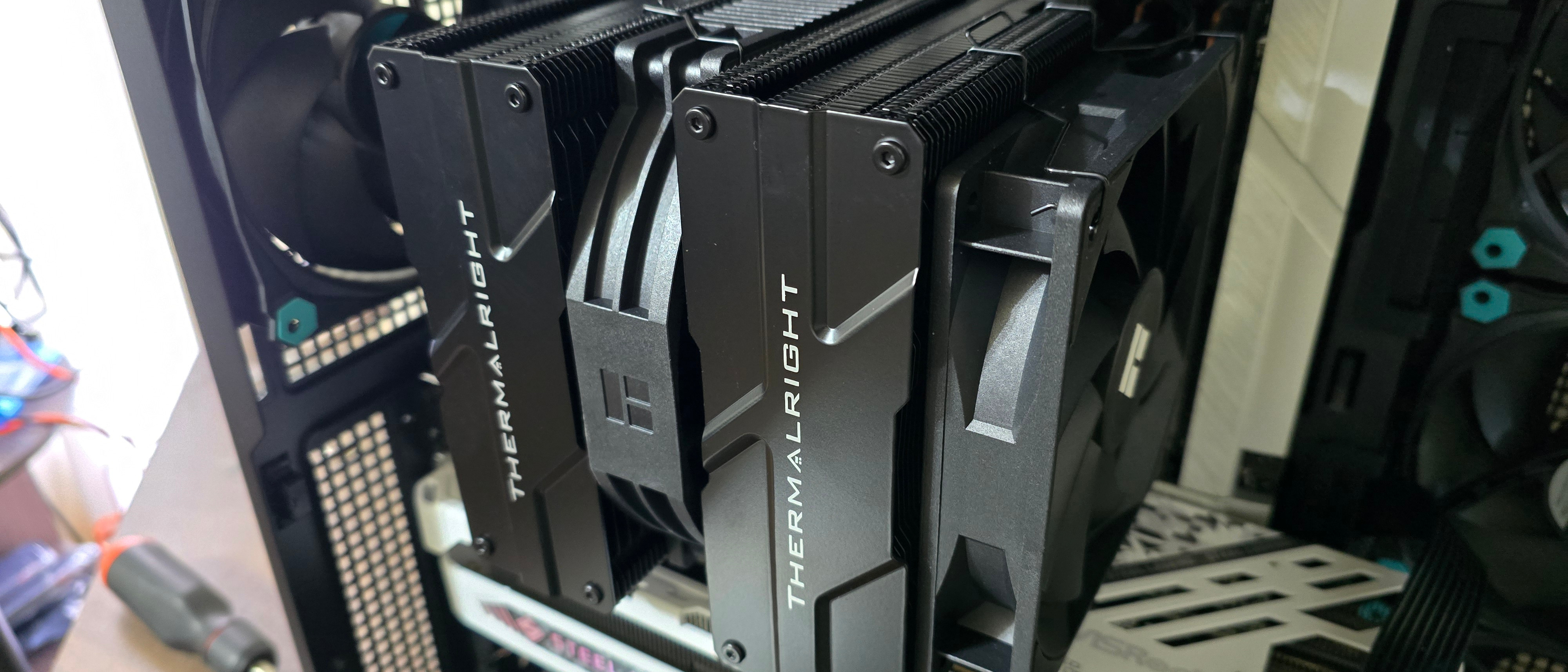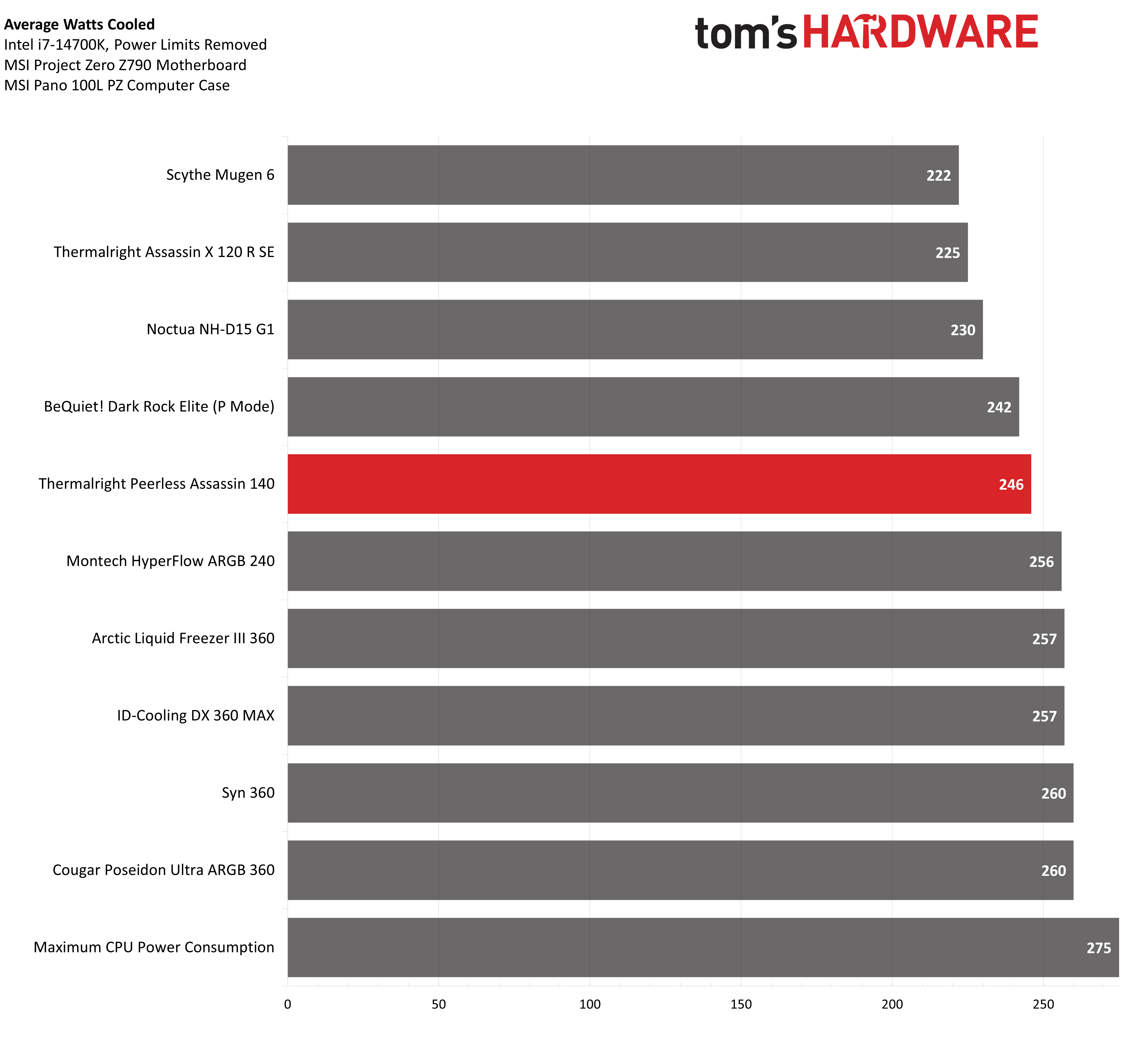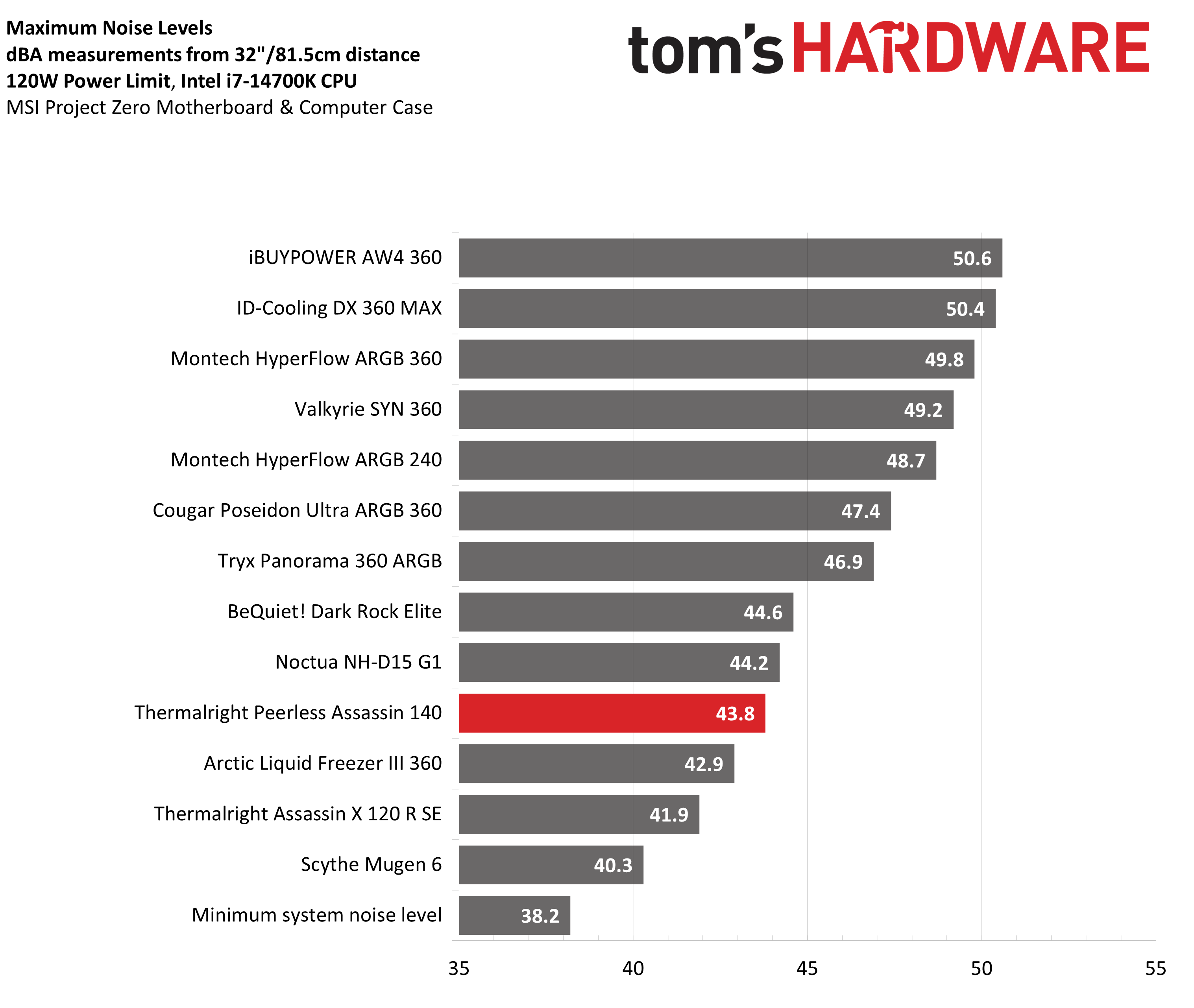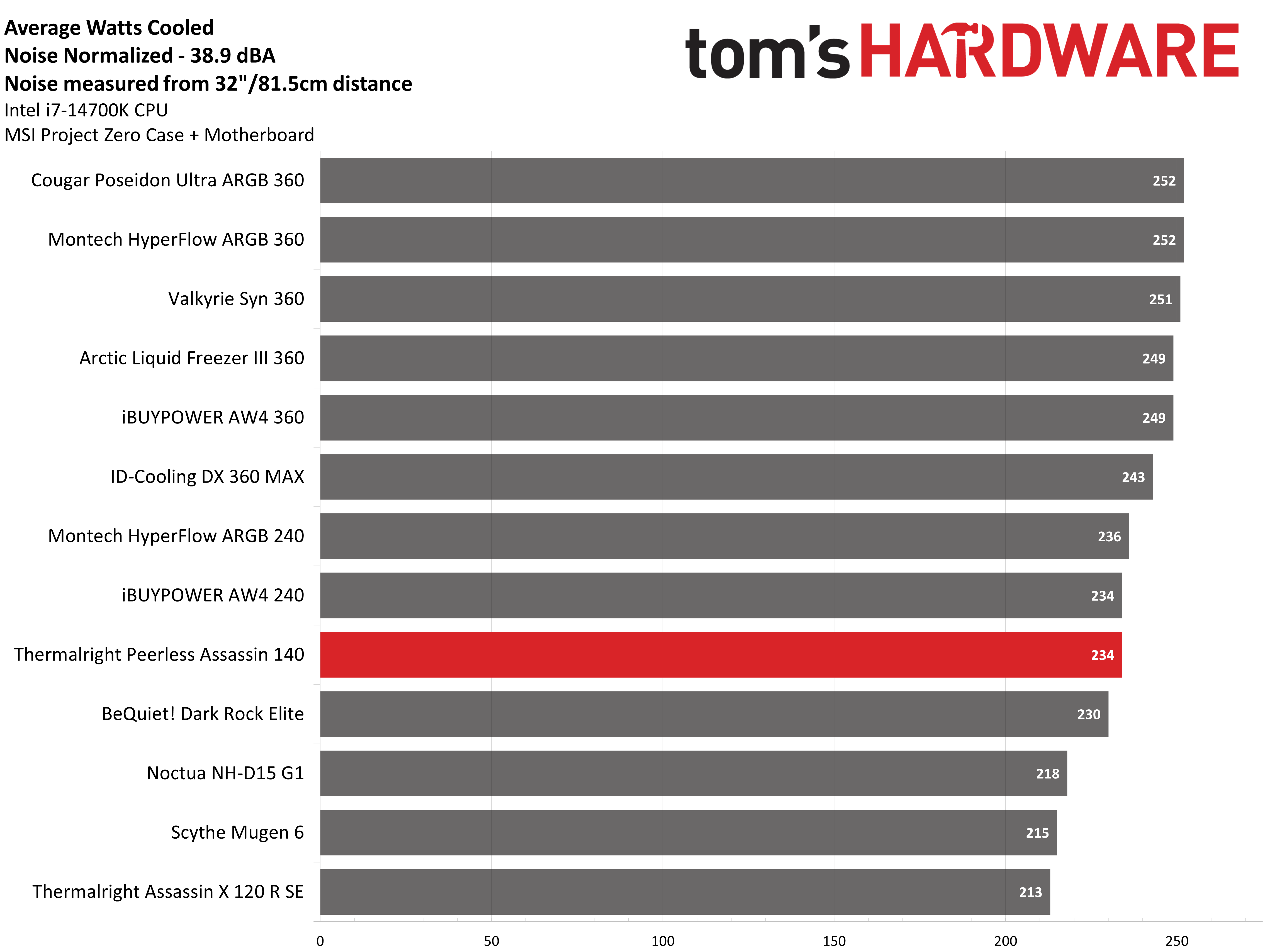Why you can trust Tom's Hardware
CPU Thermal results without power limits
Without power limits enforced on Intel’s i7-14700K, the CPU will hit its peak temperature (TJ Max) and thermally throttle with even the strongest of air coolers. When the CPU reaches its peak temperature, I’ve measured the CPU package power to determine the maximum wattage cooled to best compare their performance.
The Peerless Assassin has very good performance for an air cooler, trailing behind a top-end 240mm AIO by only 4%. Compared to air coolers, the PA 140 offered slightly better performance than BeQuiet’s Dark Rock Elite.
Maximum Noise Levels
Of course, maximum thermal performance benchmarks aren’t complete without taking into effect noise levels. The Peerless Assassin also ran slightly quieter than BeQuiet’s Dark Rock Elite, with a maximum noise volume of 43.8 dBA compared to the Dark Rock Elite’s 44.6 dBA.
Observant readers may notice that the chart above starts at 35dBA, and might be worried that this starting point may cause graphs to be deceptive. There are a few reasons that this is not something to worry about. First, noise level measurements are logarithmic. A person with typical hearing will perceive a doubling of noise for every 10 dBA increase, but the impact can vary from person to person.
Subjectively, I feel that a 5dBA increase feels like twice as loud – but I should add the disclaimer that I suffer from conditions which can make my ears more sensitive than others. 35dBA was chosen as the “zero” because it is the lowest level my noise meter can accurately measure.
Thermal results with noise normalized to 38.9 dBA
Finding the right balance between fan noise levels and cooling performance is important. While running fans at full speed can improve cooling capacity to some extent, the benefits are limited and many users prefer a quieter system. With this noise-normalized test, I’ve set noise levels to 38.9 dba. This level of noise is low, but slightly audible to most people.
When noise normalized, the Peerless Assassin 140 punches above its weight – on par with high-quality 240mm AIOs!
Get Tom's Hardware's best news and in-depth reviews, straight to your inbox.
165W CPU + 275W GPU Thermal and Noise results
I’ve recently updated my testing methodology to better represent the scenarios a user might actually encounter in real-life use. The first of these new tests is designed to emulate, though not perfectly, a CPU-intensive game with a full GPU load.
Because of the higher CPU temperature, the Peerless Assassin 140 runs almost at its maximum noise level, dropping 0.4 dBA. However, keep in mind this is for a shorter testing duration. You will likely reach the full noise levels of 43.8 in extended gaming sessions if they are CPU intensive.
110W CPU + 275W GPU Thermal results
Our second round of CPU + GPU testing is performed with a lower CPU power limit, and in theory, should be similar to games that are moderately intensive for a CPU.
The Peerless Assassin 140 reached 64 C in this scenario, 2 degrees behind BeQuiet’s Dark Rock Elite, but also 2 degrees ahead of Noctua’s NH-D15. In this scenario, I feel like noise levels are more important, which brings us to the next section.
120W Noise results
With my previous testing methodology, I used to record the temperatures and noise measurements using a 125W CPU-only test and I would emphasize how temperatures do not matter in this scenario.
As such, for this section, I’m only going to report noise levels – because that’s the only information that really matters for this test. The temperature of the CPU in this scenario is largely irrelevant, but the results for liquid coolers are similar to those reported above in the 110W + GPU tests if you are particularly concerned about this information.
The cooler reached 40.3 dBA, a moderately low noise level that shouldn’t bother most folks, but it is an audible noise level. This is on par with Noctua’s NH-D15 G1, but a bit louder than the results from BeQuiet and Scythe. However, if you’re particular about low noise levels our previous noise-normalized results show that this cooler performs well even when set to run quietly!
Conclusion
Thermalright’s Peerless Assassin 140 is a high-performance air cooler with good thermal performance and moderate noise levels. With a price of only $39.90 in the U.S., it is one of the best values on the market and will certainly earn a spot on our list of best CPU coolers.

Albert Thomas is a contributor for Tom’s Hardware, primarily covering CPU cooling reviews.
-
Notton Reply
Because a 140mm would never fit over the RAM sticks. Especially the RGB tall ones that everyone loves.brandonjclark said:Why are there two different sized fans? -
tennis2 @Albert.Thomas are the fins press-fit? Gotta imagine they are for the cost, but wanted to verify.Reply -
-Fran- I've always wondered how the life/duration* of the fans looks like. The fans look cheap compared to most other coolers, so I guess a revisit for the fans down the line would be good? Well, from people using them.Reply
Everyone wonders in the industry how Thermalright gets away with such low prices, but for us it's great they can and get away with it :D
Thanks a lot for the great data as always Albert. I hope your AMD system arrives soon :D
Regards. -
newtechldtech Reply
how can a fan "look" cheap ?-Fran- said:I've always wondered how the life/duration* of the fans looks like. The fans look cheap compared to most other coolers, so I guess a revisit for the fans down the line would be good? Well, from people using them.
Everyone wonders in the industry how Thermalright gets away with such low prices, but for us it's great they can and get away with it :D
Thanks a lot for the great data as always Albert. I hope your AMD system arrives soon :D
Regards. -
-Fran- Reply
Plastic finish mainly. In the pictures, at least to me so feel free to disagree, it looks like the brittle plastic that could break under stress or in dry conditions.newtechldtech said:how can a fan "look" cheap ?
Regards. -
Roland Of Gilead Reply
Isn't that because they sell direct to consumer? I'm pretty sure I've read that. Cut out the middleman, sell for lower price. I could be wrong there though. Can't find the reference now.-Fran- said:Everyone wonders in the industry how Thermalright gets away with such low prices, but for us it's great they can and get away with it :D
I think your statement should be reversed. If TT can produce really good quality units that perform really well, shouldn't the question be, why are other manufacturers charging so much for what are essentially inferior products? -
Amdlova Reply
The truth... Two fans same model can produce a high pitched sound... last month build a ryzen with a thermalright two towers like that. Don't remember what model. But the heat sink comes with two fans same model. Result bad noise.brandonjclark said:Why are there two different sized fans? -
Albert.Thomas Reply
Some manufacturers do this to create a "vortex" effect, claiming that it increases overall static pressure.brandonjclark said:Why are there two different sized fans?
But it was probably done to save costs and to avoid RAM compatibility issues.








